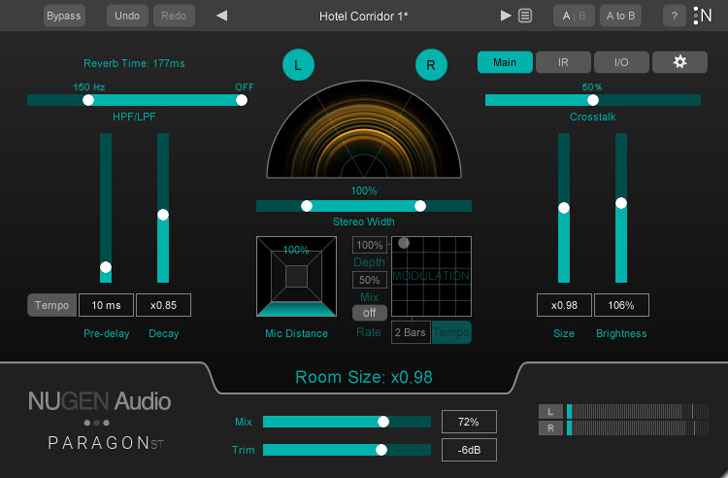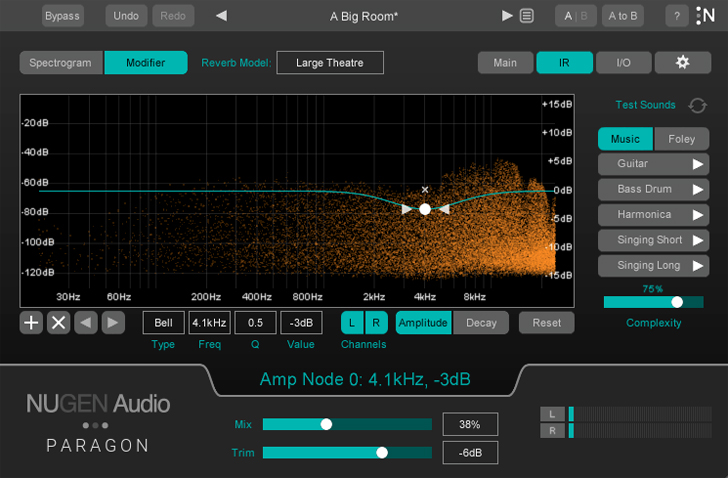|
|
NUGEN Audio Paragon ST Plugin Reverb
|
|
|
 |
| NUGEN Audio Paragon ST Plugin Reverb Main Page |
 |
| NUGEN Audio Paragon ST Plugin Reverb Modifier Page |
The long-awaited mono/stereo (only) version of NUGEN Audio's Paragon Convolution 7.1.2 Surround Sound Reverb is here.
Paragon ST (ver 1.2.0.7) copies its big brother and uses immersive Ambisonic recordings for its impulse responses and the same unique re-synthesis technology to offer the parameter adjustability of an algorithmic reverb.
Re-synthesis happens with only certain parameter changes; a visual indicator in the top-right corner of the GUI window spins for a short time lag before the new settings take eaffect. Re-synthesizing the IR to your specific needs is valuable for two reasons: fewer impulse responses are required to be stored and pre-loaded into the plugin, plus there is no time-stretching of the IRs as is typical with other convolution reverbs. This means there are never any unpleasant artifacts produced when stretching or contracting an IR file to suit a particular use.
Re-synthesis is required whenever modifying the selected IR. This includes parameters like: reverb time decay, size of the modeled space, brightness of the IR's three-dimensional space, the reverb decay time at a certain frequency, and the mic distance control that adjusts the balance of early and late reflections in the selected IR.
Especially created for music mixers/engineer/producers, both the surround and the Paragon ST versions have been recently updated with controls for adjusting stereo width up to 200% using NUGEN Audio's mid/side widening algorithm technology, which is now also available with the surround version. A reverb tail modulation section/interface has been added and the updated reverb pre-delay control is adjustable in musical notation from a one thirty-second 1/32th note to a full measure or in conventional milliseconds. The plug-in also automatically detects session tempo.
Also locked to session tempo (or not) is the modulation section that applies pitch shifting/detuning of the reverb itself. A reverb's sound is enriched using chorusing or slight changes in pitch. Paragon has the controls to set the depth, mix and speed of the pitch change. If tempo is selected, the speed can change over the time period, adjustable from a one eighth 1/8th note triplet up to two measures!
I used the modulation section, the widening effect, and also the mic distance feature when while modifying an IR. I found that mic distance has the effect of moving the source closer (louder) or further away from the source (quieter). Changes are more easily heard on headphones and I found it highly dependent on the IR chosen. With very short IRs, such as "Car Interior 1," I could hear some chorusing when using Paragon ST as an insert and the mix control (Wet/Dry) around 50%.
My first tests led me to open and learn the IR panel where the selected impulse response is depicted in the spectrogram view--one of two windows. In this view, there is an interesting, feature of a small collection of pre-loaded music and foley test sounds you may loop-play into the selected IR for adjusting parameters. This is a great way to understand the effect of certain presets have on these generic sounds--especially for the Foley set.
As a music mixer, I had little use for this feature, but I liked it when searching for an IR. I counted 19 IRs and 83 presets installed, and that is plenty for starting out and configuring a reverb. The IRs are named and cataloged in a built-in mini search engine, according to by what they are and where they were recorded with names like "Large Hall" or "Bright Room." There are also presets that are named by their immediate sonic eaffect, such as: "Add Presence" or "Add Warmth."
The other view in IR is called "Modifier," and its look has somewhat changed with the new update from when I looked at the original Paragon Surround version. One fader called "Complexity," I found used to set the resolution of the re-synthesized modeled IR, I found totally useful to for auditioning when using Paragon for vocals, choirs or keyboards.
Superimposed over the spectrogram is a parametric EQ curve with button/controls over its curve shape--be it a high- or low- shelf or bell (Gaussian), its frequency of inflection, the Q of the curve, andor the amplitude of the reverb at that selected frequency. Unlike an equalizer just placed on the reverb's output, you are altering the spectral frequency decay times when re-synthesizing the IR. For example, you could easily make only the low frequencies in Paragon's reverb very short with this interface.The I/O panel in Paragon ST has some great features I have not seen before in other reverb plug-ins. You can individually mute the left or right channels and separately set the L/R 12dB/octave HPF/LPF faders that are linked together in one fader back on the main page.
These controls provide a fast way to tailor the overall "thickness" or "darkness" of the reverb itself. I also thought the ability to have offset the pre-delay values for the left and right channels was brilliant, and I am planning to use it as my secret sound desigdn weapon on my next mix.! Lastly, the ST version retains the surround's crosstalk faders. Crosstalk adds liveliness and interaction between channels and allows the production of reverb from mono or stereo sources.
Just an excellent reverb that I've added to my Pro Tools stereo mix template because of its awesome design and sound, NUGEN Audio Paragon ST is $299 MSRP and is currently available at an introductory price of $149 (until December 6, 2021)!
|
|
|